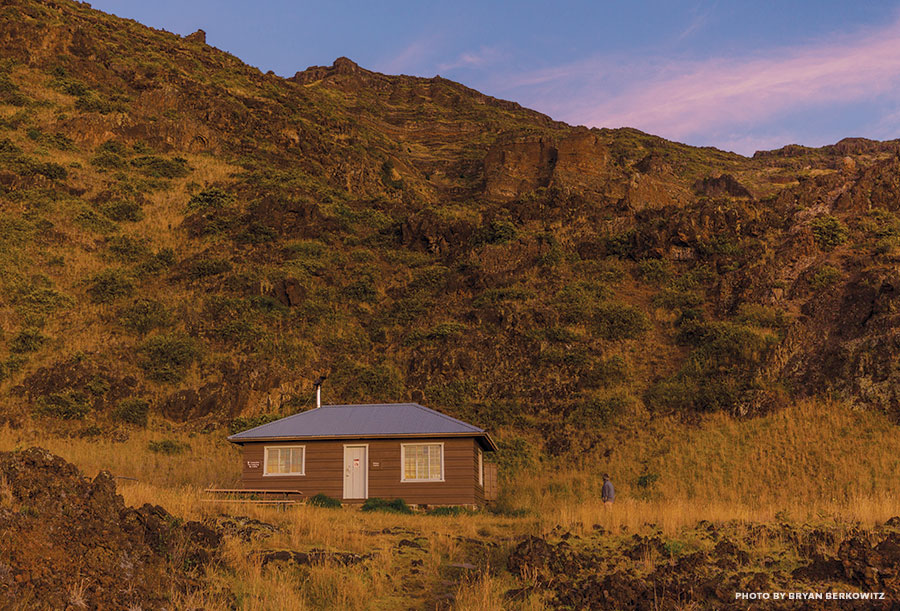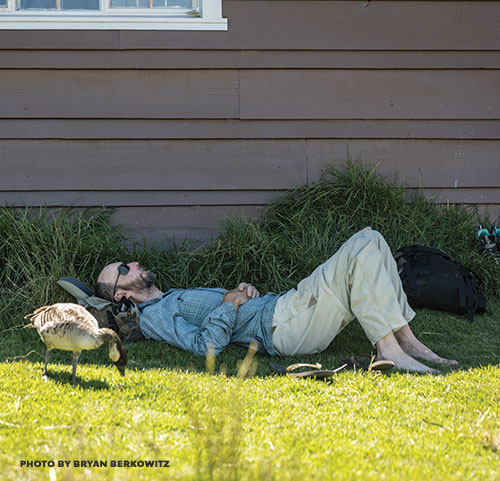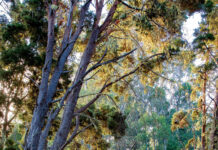Our mission: Descend Keonehe‘ehe‘e, the meandering, multihued, well-packed track better known by its English translation, “Sliding Sands Trail,” cross the “crater” to sturdy little Hōlua Cabin, stuff our faces with burritos, sack out, and the next day tackle the noxious weed known as “telegraph plant,” or Heteorotheca grandiflora. Our third day, we’d mostly work on cabin maintenance before hiking out again, this time up the Halema‘uma‘u Trail, locally known as “Switchbacks.” Hōlua, like Kapala‘oa and Palikū cabins, was built by the famous Civilian Conservation Corps, or CCC, in the 1930s, and retains that hefty, anchored-to-the-earth feel that the architecture of that era evokes.

After our steady seven-mile descent and trek across the valley floor, the cool green grass snuggling up to the old stone walls of Hōlua Cabin welcomed our sweaty backs. We’d had lunch on the trail, feasting our eyes on the view, and Matt often pointed out native plants and geologic features, or talked about park policy and the reasons for the rules. It was easy to see why “Stay on Trail” is such an important point: All along the trailside were wandering human footprints stamped into soft cinder that must have, until then, lain undisturbed for ages. As careless graffiti went, it was ugly, and sad to see.

At one point in our hike, we were overtaken by a tidal wave of European twentysomethings led by a local hostel host, all thirty-one of them (I counted) chattering away as they surged past in a flash of water bottles and accents and hot pink sunburns. At last we reached Hōlua, where an old hitching post served as the “humans dangle from it and stretch things” post, and after catching our breath and choosing our bunks, we launched into burrito-crafting and turned in early while the ‘ua‘u, or Hawaiian petrels, moaned their “ooooooo ah oooo” calls from nesting burrows in the stacked cliffs behind the cabin. The nearly full moon, when it rose, was bright enough to read by. Handy, since the outhouse was a short walk away.
I woke in my padded bunk on that first morning to the sounds of people scrambling to reach the windows for a stunning, hot gold sunrise. “Hot” would turn out to be the theme of the day, as the sky remained a flawless and unusually clear cerulean, the sunlight heavy on everything in a way you don’t feel at lower altitudes. Hōlua Cabin is tucked against the base of a cliff at about 6,700 feet above sea level, right above Ko‘olau Gap, and is often swaddled in cloud mist rising up the gap. This is why it’s important to pack for all possible weathers on trips into the summit wilderness: Haleakalā conditions can switch on you and confound you, presenting as one thing and developing as another. All of us had packed for the expected (and typical) rain and misty cold. What we got was a near-nuclear clarity and relentless sun. Bryan, also a returning service-trip volunteer, stood that morning outlined in the sunshine streaming in the open cabin door and remarked, “Well this is odd; usually my fingers are numb from cold.”
After breakfast — and an hourlong scramble over ankle-challenging scree that fanned out from the great crumbling cliff above — we arrived at the site of the worst Heterotheca g. infestation: a long sloping field of thin, tan soil with a van-sized boulder perched near the top and a bordering of native bracken ferns. Heterotheca g. is a fuzzy, broad-leafed, smallish plant that emerges from the ground looking just a bit like a plush cabbage. It bolts up a stalk that presents a daisy-like, disarmingly cheerful yellow flower. That flower turns out seeds as fluffy and numerous as a dandelion on steroids, and therein lies the problem: Heterotheca g. could choke out many of the native plants that call Haleakalā home, plants that evolved in splendid, high-altitude isolation for countless millennia. Plants that can’t out-seed Heterotheca g. Fortunately, Heterotheca g. can’t outwalk us.





